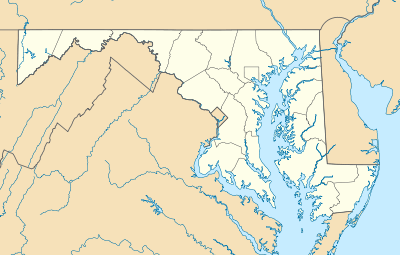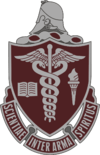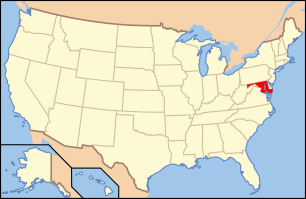Walter Reed National Military Medical Center
| Walter Reed National Military Medical Center | |
|---|---|
| Joint Task Force National Capital Region/Medical | |
 | |
|
The Walter Reed National Military Medical Center in June 2011. | |
| Geography | |
| Location | 8901 Rockville Pike, Bethesda, Montgomery County, Maryland, United States |
| Organization | |
| Care system | U.S. Military |
| Hospital type | Teaching |
| Affiliated university | Uniformed Services University of the Health Sciences |
| Services | |
| Emergency department | Level II Trauma |
| Beds | 345 |
| History | |
| Founded | November 11, 1940 |
| Links | |
| Website |
www |
| Lists | Hospitals in Maryland |
|
Bethesda Naval Hospital Tower | |
  | |
| Location | 8901 Rockville Pike, Bethesda, Maryland |
| Coordinates | 39°00′06″N 77°05′41″W / 39.00167°N 77.09472°WCoordinates: 39°00′06″N 77°05′41″W / 39.00167°N 77.09472°W |
| Area | 1 acre (0.4 ha) |
| Built | 1939 |
| Architectural style | Classical Revival |
| NRHP Reference # | 77000700[1] |
| Added to NRHP | March 8, 1977 |
The Walter Reed National Military Medical Center (WRNMMC),[2] formerly known as the National Naval Medical Center and colloquially referred to as the Bethesda Naval Hospital or Navy Med, is a tri-service military medical center located in the community of Bethesda, Maryland, near the headquarters of the National Institutes of Health. It is one of the most prominent U.S. military medical centers in the Washington, D.C. metropolitan area and the United States, having served numerous U.S. presidents since the 20th century.
In 2011, the Walter Reed Army Medical Center (WRAMC), named after yellow fever researcher Walter Reed, had been combined with the National Naval Medical Center to form the tri-service Walter Reed National Military Medical Center.
History as the National Naval Medical Center (1940–2011)
| Walter Reed National Military Medical Center | |
|---|---|
|
The JTF CapMed logo | |
| Active | November 11, 1940 – present |
| Country |
|
| Type | Military hospital |
| Part of | U.S. Department of Defense |
| Commanders | |
| Current commander | MG Jeff Clark, MC, USA |
| Insignia | |
| Army Element, Distinctive Unit Insignia[3] |
 |
Early history
In 1938, the United States Congress appropriated funds for the acquisition of land for the construction of a new Naval medical center, and President Franklin D. Roosevelt selected the present site in Bethesda, Maryland, on July 5, 1938.
Ground was broken by John McShain Builders for the Naval Medical Center on June 29, 1939 by Rear Admiral Percival S. Rossiter, MC, USN, (Ret.). President Roosevelt laid the cornerstone of the Tower on Armistice Day, November 11, 1940.
The original Medical Center was composed of the Naval Hospital, designed to hold 1,200 beds, and the Naval Medical School, the Naval Dental School (now the National Naval Dental Center) and the Naval Medical Research Institute. In 1945, at the end of World War II, temporary buildings were added to accommodate up to 2,464 wounded American sailors and marines.
Kennedy assassination
In November 1963, the autopsy of U.S. President John F. Kennedy was performed at Bethesda. On November 22, 1963, President Kennedy was shot and killed while riding in a motorcade in Dallas, Texas with his wife, Jacqueline, Texas Governor John Connally, and his wife, Nellie. The wounded president was taken to Parkland Memorial Hospital, where he was pronounced dead. The Parkland doctors and local coroner insisted that they perform the autopsy, since he had been murdered in Dallas County. However, with concern for the security of the new president, Lyndon B. Johnson, the Secret Service demanded that the assassinated president's body would be taken to Washington, D.C. immediately aboard Air Force One. This decision was made to overrule Texas law. An autopsy was performed at Bethesda Naval Hospital during the evening of November 22, 1963. The manner in which the autopsy was conducted and photographic analysis of it have become the subject of controversy (Inside the Assassination Records Review Board, Douglas P. Horne, self-published 4 volume set 2009, second print 2010).
U.S. Presidential visits to NNMC
Franklin D. Roosevelt selected the site of the hospital, laid the cornerstone, and made formal dedication remarks at the hospitals opening on November 11, 1940.
When NNMC was dedicated in 1942, its original intention was to provide medical care to military personnel only. But since Franklin D. Roosevelt had paralysis of his lower extremities, the medical center immediately offered to provide the President with any medicine or treatment necessary to keep him physically fit for the presidency. With that, an official White House doctor was appointed by the President to sort out medical issues with him. Since FDR, most presidents have used a military hospital close to Washington, D.C., either Bethesda or Walter Reed AMC, as the primary facility for them and their immediate family to receive medical care. Each president pays for any of his medical expenses personally.

Ronald Reagan, on July 13, 1985, underwent surgery to remove polyps from his colon. He sent a letter transferring power to then vice president George H. W. Bush, deliberately invoking the Acting President clause of the 25th Amendment,[4] and on January 5, 1987, Reagan underwent surgery for prostate cancer which caused further worries about his health. At this time, Reagan was 76 years old.
First Lady Nancy Reagan, on October 17, 1987, underwent a mastectomy due to breast cancer.
Modernization
In August 1960, a $5.6 million expansion project was initiated and consisted of two five-story wings attached to the main building's east side. Completed in the summer of 1963, Buildings 7 and 8 provided space for 258 beds and replaced the World War II temporary ward buildings.
In January 1973, the mission of the Naval Medical Center was modified to include the provision: "to provide coordinated dispensary health care services as an integral element of the Naval Regional Health Care System, including shore activities, as may be assigned." This change established the National Naval Medical Center Region and placed all naval health care facilities within the Naval District Washington under the authority of the commanding officer of the Medical Center.
The new inpatient buildings and the Naval Medical Center were consolidated into one command on September 1, 1973, to form National Naval Medical Center. In 1975, an extensive renovation began which included the construction of two new buildings: Building 9, a three-story outpatient structure, and Building 10, a seven-story, 500 bed inpatient facility, with a combined area of more than 880,000 square feet (82,000 m²).
In 1979, the remaining temporary buildings were replaced with a multi-level staff-parking garage. This addition made National Naval Medical Center one of the largest medical facilities in the country. The original Naval Medical Center tower was since listed on the National Register of Historic Places by the U.S. Department of the Interior.
Lawsuits
In early 1994, after two unsuccessful operations following strokes, both legs of Dr. Milton Wittman, DSW, a nationally acclaimed administrator and pioneer of public mental health services in the National Association of Social Workers[5] and the National Institute of Mental Health,[6] had to have both his legs amputated due to casts being improperly casted on his legs. Wittman's family, specifically his sons Dr. Friedner Wittman of UC Berkeley and Peretz Wittman sued Bethesda Naval Hospital for gross malpractice. The lawsuit was dragged out in court, and after some time, the United States Navy paid over $500,000 to Wittman, mostly covering the end-of-life treatment Wittman would then need due to the malpractice by the doctors.
History as the WRNMMC (2005–present)
Facility merger
In accordance with the 2005 Base Realignment and Closure recommendations, an Office of Integration (OI) was formed in November 2005 to oversee the merger of the Walter Reed Army Medical Center (WRAMC) and the National Naval Medical Center (NNMC). That merged facility was to be staffed by Army, Navy, and Air Force medical personnel and become the core of an integrated military medicine system in the National Capital Region (NCR). What in 2005 were three medical centers, a small community hospital, and 19 clinics offering medical care to military beneficiaries in the NCR was to become, with oversight of the OI, a single tri-service medical center, a large tri-service hospital in Northern Virginia, and 20 area clinics.
Construction and cost overruns

Groundbreaking took place on July 3, 2008, with President George W. Bush officiating.
The goal of the merger was for the government to ultimately spend less maintaining a new building than an old one. It was estimated that the new facility would cost about $172 million less to manage each year. The original 2005 estimate of the cost of shutting down WRAMC, and shifting it across town to Bethesda, and other locations, was "just under $900 million" according to Brian Lepore of the Government Accountability Office (GAO).

The "payback period" — i.e., the point after which the full amount of the investment will have been recouped and at which savings actually commence — was to have started in 2011. But the relocation cost unexpectedly rose by 245% between the original 2005 projection and the 2011 opening. Instead of under $900 million, it turned out to be about triple that at $2.7 billion. Thus the payback period is expected to begin about seven years late, around 2018. One reason costs skyrocketed was that construction costs went up, partly due to a huge amount of building materials being sent to the Gulf Coast in the wake of Hurricane Katrina. According to Todd Harrison, a defense analyst with the Center for Strategic and Budgetary Assessments, in 2005, "when they made their initial estimates of what it would cost … they did their best estimate …. A lot of things have changed since then. Construction costs have gone up." The GAO agrees that the WRNMMC project tripled in price mostly because of a rise in construction costs.[7]
The NNMC was rechristened Walter Reed National Military Medical Center on September 14, 2011, shortly after the closing of the WRAMC.
Current operations
WRNMMC serves as the location of the headquarters for Joint Task Force National Capital Region/Medical, a tri-service task force providing command and control for most medical treatment facilities in the District of Columbia and Northern Virginia, Maryland, Pennsylvania, West Virginia and New Jersey. The WRNMMC continues to provide all the services it provided as NNMC, having additionally absorbed many departments and services from WRAMC.
In September 2013, a ceremony placed U.S. Army Major General Jeff Clark as the commander of Walter Reed National Military Medical Center - Bethesda. MG Clark is the first Army commander of the medical center.
List of commanders
Commanders of the National Naval Medical Center
| Dates of Service | Commander |
|---|---|
| 1935–1936 | CAPT Ulys R. Webb, MC, USN |
| 1936–1938 | RADM C.S. Butler, MC, USN |
| 1938–1941 | RADM H.W. Smith, MC, USN |
| 1941–1942 | RADM C.M. Oman, MC, USN |
| 1942–1944 | RADM C.W.O. Bunker, MC, USN |
| 1944-1944 | CAPT John Harper, MC, USN |
| 1944–1946 | RADM W.M. Chambers, MC, USN |
| 1946–1948 | RADM T.C. Anderson, MC, USN |
| 1948–1951 | RADM M.D. Willcutts, MC, USN |
| 1951-1951 | RADM C.A. Swanson, MC, USN |
| 1951–1952 | RADM W.J.C. Agnew, MC, USN |
| 1952–1953 | RADM B. Groesbeck, Jr., MC, USN |
| 1953–1955 | RADM L.O. Stone, MC, USN |
| 1955–1956 | RADM H.L. Pugh, MC, USN |
| 1956-1956 | CAPT E.C. Kenney, MC, USN |
| 1956–1959 | RADM T.F. Cooper, MC, USN |
| 1959–1960 | RADM B.E. Bradley, MC, USN |
| 1960–1962 | RADM F.P. Kreuz, MC, USN |
| 1962–1963 | RADM R.B. Brown, MC, USN |
| 1963–1965 | RADM C.C. Galloway, MC, USN |
| 1965–1966 | RADM C.L. Andrews, MC, USN |
| 1966–1968 | RADM G.M. Davis, MC, USN |
| 1968–1969 | RADM R.O. Canada, MC, USN |
| 1969–1973 | RADM F.P. Ballenger, MC, USN |
| 1973–1975 | RADM R.G.W. Williams, MC, USN |
| 1975–1976 | RADM D.E. Brown Jr., MC, USN |
| 1976–1981 | RADM J.T. Horgan, MC, USN |
| 1981–1984 | RADM Q.E. Crews, MC, USN |
| 1984–1987 | COMO/RADM R.G. Shaffer, DC, USN |
| 1987–1988 | RADM Donald L. Sturtz, MC, USN |
| 1988–1991 | RADM Donald F. Hagen, MC, USN |
| 1991–1994 | RADM Davis M. Lichtman, MC, USN |
| 1994–1997 | RADM Richard I, Ridenour, MC, USN |
| 1997–1999 | RADM Bonnie B. Potter, MC, USN |
| 1999–2002 | RADM Kathleen L. Martin, NC, USN |
| 2002–2004 | RADM Donald C. Arthur, MC, USN |
| 2004–2007 | RADM Adam M. Robinson, MC, USN |
| 2007–2008 | RADM Richard R. Jeffries, MC, USN |
| 2008–2011 | RADM Matthew L. Nathan, MC, USN |
Commanders and Directors of the Walter Reed National Military Medical Center
| Dates of Service | Commander/Director |
|---|---|
| 2011–2013 | RADM Alton Stocks, MC, USN (Commander) |
| 2013–2016 | MG Jeff Clark, MC, USA (Director) |
| 2016–Present | RADM David Lane, MC, USN (Director) |
See also
- Erich Traub
- Joint Task Force National Capital Region/Medical
- Project CHATTER
- Walter Reed (disambiguation)
References
- ↑ National Park Service (2010-07-09). "National Register Information System". National Register of Historic Places. National Park Service.
- ↑ http://www.wrnmmc.capmed.mil/SitePages/home.aspx
- ↑ "Walter Reed National Military Medical Center, US Army Element". Institute of Heraldry. Office of the Administrative Assistant to the Secretary of the Army. 18 July 2011. Retrieved 19 May 2013.
- ↑ "What is the 25th Amendment and When Has It Been Invoked?". History News Network. Retrieved 2007-06-06.
- ↑ "Milton Wittman". www.naswfoundation.org. Retrieved 2016-10-24.
- ↑ Knee, Ruth Irelan (2008-04-17). "Wittman, Milton". doi:10.1093/acrefore/9780199975839.001.0001/acrefore-9780199975839-e-825.
- ↑ Bowman, Tom, "When Will Closing Walter Reed Pay Off? Maybe 2018", All Things Considered, August 15, 2011.
External links
| Wikimedia Commons has media related to National Naval Medical Center. |
- Official website
- DoD Lodging Worldwide
- Navy Lodge Bethesda
- National Naval Medical Center at the Wayback Machine (archived September 26, 2002)
- Bethesda Naval Hospital Tower, Montgomery County, including photo in 1975, at Maryland Historical Trust website


.svg.png)

